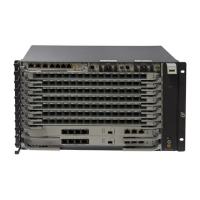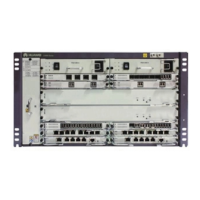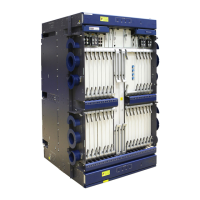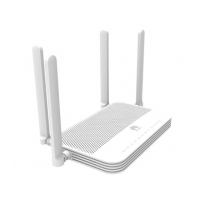Do you have a question about the Huawei SMU11B and is the answer not in the manual?
Describes the module, panel, ports, WebUI, application guide, and features of the SMU.
Specifies the target readers for this document, including sales engineers, technical support, and maintenance engineers.
Defines the meaning and usage of symbols like DANGER, WARNING, CAUTION, and NOTICE within the document.
Details the appearance and physical characteristics of the SMU11B monitoring module.
Explains the status and meaning of the SMU11B's indicator lights, such as running and alarm indicators.
Details the pin definitions for SIG1 and SIG2 wiring terminals on the SMU11B, used for dry contact inputs and battery voltage detection.
Describes the COM and FE communication ports on the SMU11B, including their pin definitions and functions.
Details the appearance, power input port, and communication ports of the MUE03A expansion box.
Provides a step-by-step guide on how to connect a network cable to the FE port of the SMU for establishing communication.
Explains how to configure PC IP settings and access the SMU's WebUI login page via a browser.
Covers the configuration and login procedures for managing the SMU using the NetEco system.
Details the steps for setting up IP networking for the SMU to connect to the NetEco system.
Guides users on how to log in to the NetEco interface using the system's IP address and port number.
Explains how to manage the SMU using SNMP, including connecting cables and setting parameters.
Describes the process of connecting a network cable to the SMU's FE port for SNMP communication.
Provides instructions and prerequisites for configuring SNMP settings, including versions, community names, and trap parameters.
Briefly mentions querying power system status via NMS and refers to NMS documentation for details.
Explains how to back up the current system configuration to a file for future use or deployment on other sites.
Describes how to quickly configure site parameters by importing a previously saved configuration file.
Details how to restore all parameter values to their default factory settings and advises backing up current settings first.
Guides users on upgrading software for the SMU BSP, SMU, and other associated devices via the WebUI.
Explains how to import an individual file, which may cause the SMU to restart after import.
Details the procedure for system administrators to change user passwords for security purposes.
Describes how to view currently active alarms on the SMU, displaying severity, equipment, and generation time.
Explains how to filter and view historical alarms that have been generated and cleared, including their details.
Guides users on how to query version numbers to help locate fault causes and verify upgrades.
Explains how the SMU collects fault information about lithium batteries and rectifiers for fault locating.
Describes how to export historical alarms, e-label information, and system operating information for fault identification.
Outlines the necessary conditions before installing a cable for the expansion box.
Provides step-by-step instructions for connecting a communication cable between the expansion box and the SMU.
Lists the necessary equipment and conditions before replacing the SMU11B, such as ESD protection.
Details the steps for removing the old SMU11B module from the subrack, including ESD precautions.
Lists AIM alarms, their enabled status, severity levels, and relay configurations.
Lists ibox alarms, their enabled status, severity levels, and relay configurations.
Describes the module, panel, ports, WebUI, application guide, and features of the SMU.
Specifies the target readers for this document, including sales engineers, technical support, and maintenance engineers.
Defines the meaning and usage of symbols like DANGER, WARNING, CAUTION, and NOTICE within the document.
Details the appearance and physical characteristics of the SMU11B monitoring module.
Explains the status and meaning of the SMU11B's indicator lights, such as running and alarm indicators.
Details the pin definitions for SIG1 and SIG2 wiring terminals on the SMU11B, used for dry contact inputs and battery voltage detection.
Describes the COM and FE communication ports on the SMU11B, including their pin definitions and functions.
Details the appearance, power input port, and communication ports of the MUE03A expansion box.
Provides a step-by-step guide on how to connect a network cable to the FE port of the SMU for establishing communication.
Explains how to configure PC IP settings and access the SMU's WebUI login page via a browser.
Covers the configuration and login procedures for managing the SMU using the NetEco system.
Details the steps for setting up IP networking for the SMU to connect to the NetEco system.
Guides users on how to log in to the NetEco interface using the system's IP address and port number.
Explains how to manage the SMU using SNMP, including connecting cables and setting parameters.
Describes the process of connecting a network cable to the SMU's FE port for SNMP communication.
Provides instructions and prerequisites for configuring SNMP settings, including versions, community names, and trap parameters.
Briefly mentions querying power system status via NMS and refers to NMS documentation for details.
Explains how to back up the current system configuration to a file for future use or deployment on other sites.
Describes how to quickly configure site parameters by importing a previously saved configuration file.
Details how to restore all parameter values to their default factory settings and advises backing up current settings first.
Guides users on upgrading software for the SMU BSP, SMU, and other associated devices via the WebUI.
Explains how to import an individual file, which may cause the SMU to restart after import.
Details the procedure for system administrators to change user passwords for security purposes.
Describes how to view currently active alarms on the SMU, displaying severity, equipment, and generation time.
Explains how to filter and view historical alarms that have been generated and cleared, including their details.
Guides users on how to query version numbers to help locate fault causes and verify upgrades.
Explains how the SMU collects fault information about lithium batteries and rectifiers for fault locating.
Describes how to export historical alarms, e-label information, and system operating information for fault identification.
Outlines the necessary conditions before installing a cable for the expansion box.
Provides step-by-step instructions for connecting a communication cable between the expansion box and the SMU.
Lists the necessary equipment and conditions before replacing the SMU11B, such as ESD protection.
Details the steps for removing the old SMU11B module from the subrack, including ESD precautions.
Lists AIM alarms, their enabled status, severity levels, and relay configurations.
Lists ibox alarms, their enabled status, severity levels, and relay configurations.
| Brand | Huawei |
|---|---|
| Model | SMU11B |
| Category | Network Hardware |
| Language | English |











